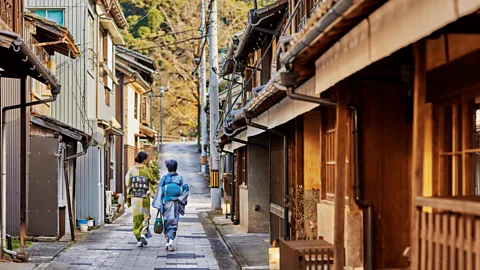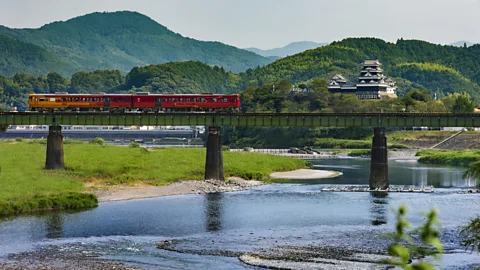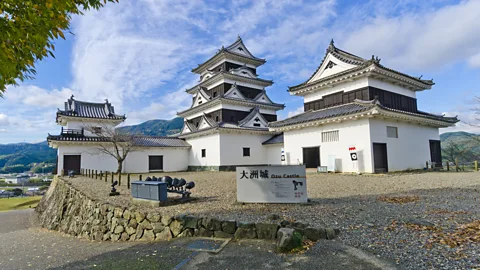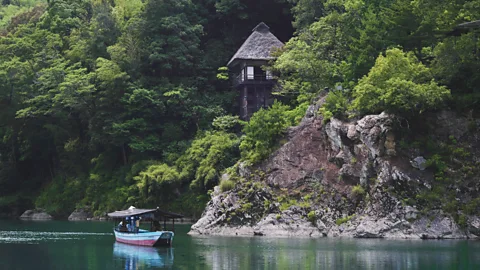Why you should visit Japan's small but mighty 'little Kyoto'
 Ozu City Tourism
Ozu City TourismIn Ozu, you can stay at a hotel dispersed across an ancient castle, samurai residences and old merchant homes, while supporting the town's award-winning model of sustainable tourism.
I arrived at Ozu via a narrow pass winding through the mountains of western Shikoku, the smallest of Japan's four main islands. As I descended into a basin formed by a horseshoe bend of the Hiji River, Ozu Castle appeared: a four-tiered, timber-clad fortress dating to the 14th Century perched atop a central hill. Nestled protectively behind it, hugging the riverbank, lay the ancient town. The scene's allure was heightened by a gentle mist rising from the river that swirled around the snow-dusted mountains.
I'd previously visited Ozu in 2018, making a quick stop to see its castle while on a trip further south. At that time many of the old town's buildings were neglected, some were abandoned, with a few even demolished. The city was fairly deserted and, after a quick stroll around, I continued on my way.
However, on my latest trip in February 2024, I was amazed by Ozu's remarkable transformation. The old town was bustling with life and the plaza in front of Ozu Machi-no-Eki Asamoya, which serves as a tourist information centre and local crafts and food emporium, resembled a lively village square, with local families mingling among the visitors. Heading to my hotel, I passed a row of elegant samurai residences with large gardens. One housed Shun, a restaurant serving Ozu's specialty of imotaki, a traditional stew of chicken, taro and other vegetables, where a queue stretched out for lunch. On the opposite side of the street, in traditional castle town configuration, were merchants' establishments; their storehouses newly plastered and white-washed and now home to cafes, bars and a local history museum.
Often referred to as a "little Kyoto" thanks to a similar historical appeal, Ozu was once the capital of the old Iyo feudal domain (much of present-day Ehime prefecture) from 1617 to 1868, and its merchants became wealthy from the production and trade of wax, silk, paper and timber. However, Ozu's economic decline over the past century, like many river towns worldwide, led to decaying heritage sites and the exodus of residents to major cities.
 Ozu City Tourism
Ozu City TourismIn order to preserve the medieval townscape and revitalise the local economy, in 2019, Ozu embarked on an ambitious plan centred on sustainable tourism, swiftly working to conserve and convert its heritage structures into attractive accommodations and new businesses. The goal was to restore Ozu as the cultural heart of the region and attract both tourists and residents.
When to go and what to do:
Spring: Wander the cherry blossom-filled paths that line the hill below Ozu Castle.
Summer: Take a boat ride on the Hiji River to watch the traditional ukai fishing method, where skilled handlers use trained cormorants to catch fish.
Autumn: Enjoy the vibrant foliage at Shirataki Park, recognised as one of Japan's top 100 fall foliage-viewing spots.
Winter: Witness the Hijikawa Arashi, a rare natural phenomenon of fog that envelops Ozu then flows down the Hiji River, becoming a windstorm as it reaches its mouth and blows out into the Seto Inland Sea.
And it has been an amazing success story. In 2023, Ozu was named one of the Top 100 Sustainable Tourism Destinations by Green Destinations, an international official certification body and non-profit organisation. That same year, it was awarded first place in the Culture and Tradition category of Green Destinations' Story Awards, recognised for how it has breathed new life into the town by repurposing its cultural assets. Ozu is now leading the way in Japan's ambitions to be one of the most sustainable travel destinations in the world.
I was staying at Nipponia Ozu Castle Town Hotel, which is the centrepiece of the town's revitalisation. It's a "scattered hotel", an innovative public-private partnership between the Ozu City government and community stakeholders, where the hotel's central services and rooms are spread out across various buildings and locations within the town rather than being centralised in a single site.
When it opened in 2020, it offered visitors the first chance in Japan to sleep overnight in a castle. Guests can also stay in 31 rooms within 26 other meticulously restored buildings dispersed across the small city. By integrating guests into the community, the hotel provides them with a unique opportunity to experience the city while preserving Ozu's historic townscape and the integrity of its way of life.
"Ozu's transformation is a miracle" given how quickly, thoroughly and successfully it happened, said hotel manager Yuki Inao, noting that the castle was nearly fully booked in 2023, the year Japan lifted its travel restrictions post-pandemic.
A stay at Ozu Castle is an elaborate affair. The experience begins after 17:00 when the castle museum closes. Guests arrive wearing kimono or samurai armour, entering the castle on horseback escorted by a retinue of samurai retainers who are local actors. Following a performance of traditional arts such as gagaku court music or Shinto kagura dance, dinner is served in the Koran Turret, where Ozu's former lords – 13 generations of the Kato family – sipped sake while viewing the Moon. Afterwards, guests sleep in the keep, a unique two-storey timber-latticed open well within the main castle tower. Breakfast is served the next morning in Garyu Sanso, an exquisite teahouse built by a wealthy merchant in the 1920s on the castle's pleasure garden overlooking the river.
 thanyarat07/Getty Images
thanyarat07/Getty ImagesAt ¥1,320,000 (around £7,000) per night for two guests, Ozu Castle stays are not for everyone. However, I appreciated the town's gesture of handing over the keys to its castle to guests as symbolic of its welcoming stance toward all visitors, and my stay was an equally authentic and indulgent experience.
Get there:
There are regular trains and buses from Matsuyama City, an hour away. Cyclists on the Uchiko-Naikyo Rural Cycling Course can extend their journey by another 18km to reach Ozu. Travellers walking Shikoku's famous Henro pilgrimage trail of 88 Buddhist temples will pass through Ozu as they progress from Meiseki-ji Temple to Daiho-ji Temple.
Almost all the hotel's "rooms" are suites occupying entire houses tucked into the old town from one end of its roughly 1.5km length to the other. They range from the mansion where the Kato family lived after Japan's feudal system was abolished to homes with secluded courtyard gardens and private teahouses, as well as townhouses in the bustling town centre.
My "home" for the weekend was a two-storey terrace dwelling once inhabited by a wax worker more than a century ago. The upper floor had a bedroom overlooking a narrow lane lined with quaint shops and a sitting room. A modern bathroom, complete with a traditional hinoki wood soaking tub, occupied much of the lower level. Adjacent to its spacious garden was the hotel's club lounge, where I enjoyed complimentary drinks from a self-service bar, mingling with hotel guests from other locations who stopped by for convenient refreshment while exploring the city.
Throughout the weekend, I was fully immersed in Ozu's atmosphere the moment I stepped out of my rooms. To get to the hotel's reception, I walked across a narrow cobblestone street, past an imposing earthen-walled storehouse – now transformed into another of the hotel's suites – into the grand hall of a 400-year-old mansion once owned by a wealthy wax merchant. A brief walk from there up a stone-paved street led me to breakfast – a tray of seasonal delicacies – in one of the hotel's restaurants, a former ryotei (traditional Japanese restaurant). Dinner was served in a gracious old mansion located at the foot of the castle at the opposite end of the old town, a leisurely 15-minute stroll away.
 Nipponia Hotel
Nipponia HotelThe hotel's public spaces – restaurants, banquet rooms and gardens – are also open to the public. Diego Cosa Fernandez, sustainability coordinator at Kita Management, the organisation responsible for coordinating Ozu's revitalisation plan and tourism activities, told me that the town's definition of sustainable tourism is "a balance between the people living and visiting in which everyone wins and no one loses". As I explored the town with Fernandez and his colleague Ayano Iga, it was clear that this definition has been put into practice.
Facing onto the street, the hotel's shops seamlessly blended into the townscape and stood alongside a growing number of new businesses housed in other restored structures. Tenants for these new stores have been carefully selected, with an emphasis on local and regional crafts and products, such as Tobe ware, ceramics first commissioned by the Kato family in 1777; Ikekuchi organic cotton towels; and Silmore health and beauty products made from silk by the Takimoto family, Ozu's sole remaining silk cocoon producer. "They're very popular with local residents," said Iga.
More like this:
• 10 sustainable travel destinations to visit in 2024
As I toured the town, I was impressed to find Unagi no Nedoko's trendy, traditionally made monpe farmers pants and hanten jackets at its first store located outside of its Fukuoka City base. The smart, stylish ambience of Ozu's new businesses aligned perfectly with the town's restored identity as the cultural hub of the region.
"When I asked Inao what she attributed Ozu's successful transformation to, she answered that "it's the way the city government, hotel and community are working closely together, collaboratively." "We are a family," she said.
This welcoming community spirit is also attracting a stream of new residents, according to Yosuke Inoue of Kita's strategic planning department. He left a position at a Tokyo-based company to become the 18th generation of his family to reside in the town. But he takes pride in the fact that more than half of the new residents are not returnees like himself but people new to Ozu.
 Ozu City Tourism
Ozu City TourismThe new residents I met during my stay – hotel staff, city employees and shop owners – eagerly shared their reasons for choosing Ozu as their home. Their responses were remarkably consistent: an appreciation for the town's rich historical significance, the vibrant energy and collaborative spirit, and the serene, natural surroundings. The latter sentiment resonated with me. As an avid rambler, the winding roads that led out of the town into the surrounding hills, where I found ancient Buddhist temples and Shinto shrines ringing the city, enriched my experience.
CARBON COUNT
The travel emissions it took to report this story were 0.11 metric tons of CO2e. Find out more about how we calculated this figure here.
On my final evening, I returned to the hotel's Le Un restaurant, located at the base of the castle, where each dish of the seven-course meal was a delicious reminder of Ozu's ability to harmoniously blend the old with the new, such as the tai meishi, a regional specialty featuring delicate slices of red sea bream served over rice. Departing from the tradition of serving it with raw egg yolk and a splash of soy sauce, this version was layered with sabayon and bathed in foam infused with Kajita Shoten's premium soy sauce – a sophisticated reinterpretation of a timeless classic.
Looking onto a view of the castle illuminated at night, I recalled Inoue's explanation of the town's slogan "Shiroshita no Machibito". He described it as meaning "the person expected and waited for under the castle", emphasising that it embodies Ozu's invitation to travellers to visit and become honorary citizens. As I strolled back to my rooms, I felt as if I belonged there.
Green Getaways is a BBC Travel series that helps travellers experience a greener, cleaner approach to getting out and seeing the world.
--
Join more than three million BBC Travel fans by liking us on Facebook, or follow us on Twitter and Instagram.
If you liked this story, sign up for The Essential List newsletter – a handpicked selection of features, videos and can't-miss news delivered to your inbox every Friday.
